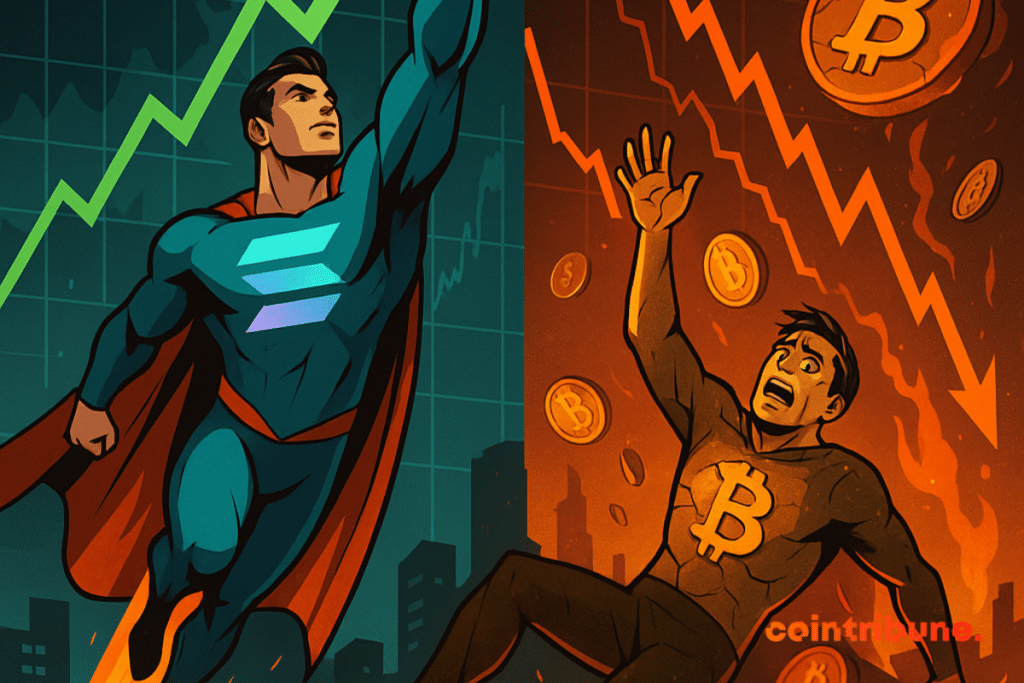Solana ETFs See Explosive Growth Amid Bitcoin’s Downturn
The crypto market is experiencing a turbulent start to the quarter. While Bitcoin wavers under the weight of massive capital outflows, Solana surprises by attracting an unprecedented institutional influx. A striking contrast that illustrates a possible turning point in the crypto market balance.

In brief
- Solana records nearly 199 million dollars in inflows while Bitcoin ETFs suffer significant outflows
- Despite this enthusiasm, Solana’s performance and liquidity still lag far behind those of Bitcoin
- These flows mark a symbolic turning point, revealing growing institutional interest in alternatives to the historical leader
A subtle but spectacular shift
The crypto market is going through a unique moment. On one side, Bitcoin, once unbeatable, sees its ETFs record nearly 799 million dollars in outflows in a week, even though, paradoxically, its market capitalization has increased by more than 8 billion dollars over the same period. On the other, Solana, often presented as the eternal alternative, attracts more than 199 million dollars in inflows in just four days.
This reversal of flows is striking. Institutional investors, long faithful to King Bitcoin, now seem to be taking a closer look at its successor. Bitwise and Grayscale, through their products BSOL and GSOL, have paved the way for new appetite for the Solana ecosystem. Both have seen their volumes explode, and Bitwise even claimed 417 million dollars in weekly inflows, a performance surpassing all other crypto ETPs combined.
But this rise is not just about numbers. It also reflects a change in perception: Solana is no longer seen as a mere “fast alternative to Ethereum,” but as a credible institutional asset capable of capturing some of the capital previously reserved for Bitcoin.
Solana skyrockets, but the gap remains clear
The flows tell a compelling story, but the charts remind us of reality. Despite the massive capital influx, Solana’s momentum remains four times lower than that of Bitcoin. Worse, the SOL/BTC ratio slipped nearly 8% over the last quarter.
In other words, investors are betting on Solana, but the price dynamics do not yet follow. Institutional interest seems more speculative than operational, an anticipation rather than validation.
Bitcoin remains sovereign. Even weakened, it still dominates macro trends, market structures, and overall liquidity. Solana consolidates where BTC breathes. And this nuance is crucial: investors are repositioning, but the market is still waiting for confirmation.
Hesitant liquidity, but a strong symbol
On-chain, Solana’s Total Value Locked (TVL) remains oddly stable throughout the fourth quarter. No marked growth, despite enthusiasm around ETFs. This plateau reveals a paradox: speculative interest rises, but real liquidity stagnates.
This shows that Solana, although attractive, has not yet absorbed the structural energy necessary to sustainably compete with Bitcoin or Ethereum. However, these ETFs mark a considerable advance: it is the first time Solana establishes itself in the institutional universe, where only giants had so far had access.
This signal alone changes the game. It signals the beginning of diversification within institutional crypto capital, a subtle but fundamental shift. Where BTC symbolized the store of value, Solana now embodies efficient innovation, a technological bet rather than a financial insurance.
Maximize your Cointribune experience with our "Read to Earn" program! For every article you read, earn points and access exclusive rewards. Sign up now and start earning benefits.

Fascinated by Bitcoin since 2017, Evariste has continuously researched the subject. While his initial interest was in trading, he now actively seeks to understand all advances centered on cryptocurrencies. As an editor, he strives to consistently deliver high-quality work that reflects the state of the sector as a whole.
The views, thoughts, and opinions expressed in this article belong solely to the author, and should not be taken as investment advice. Do your own research before taking any investment decisions.